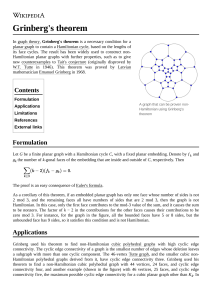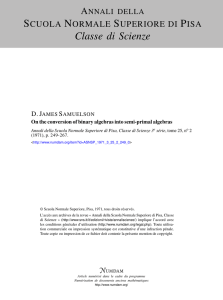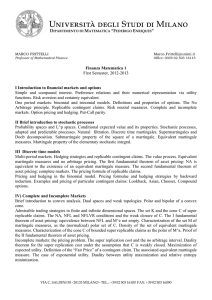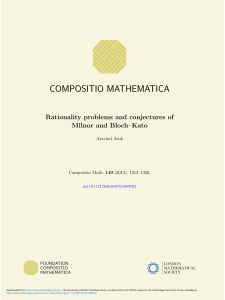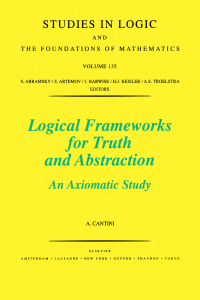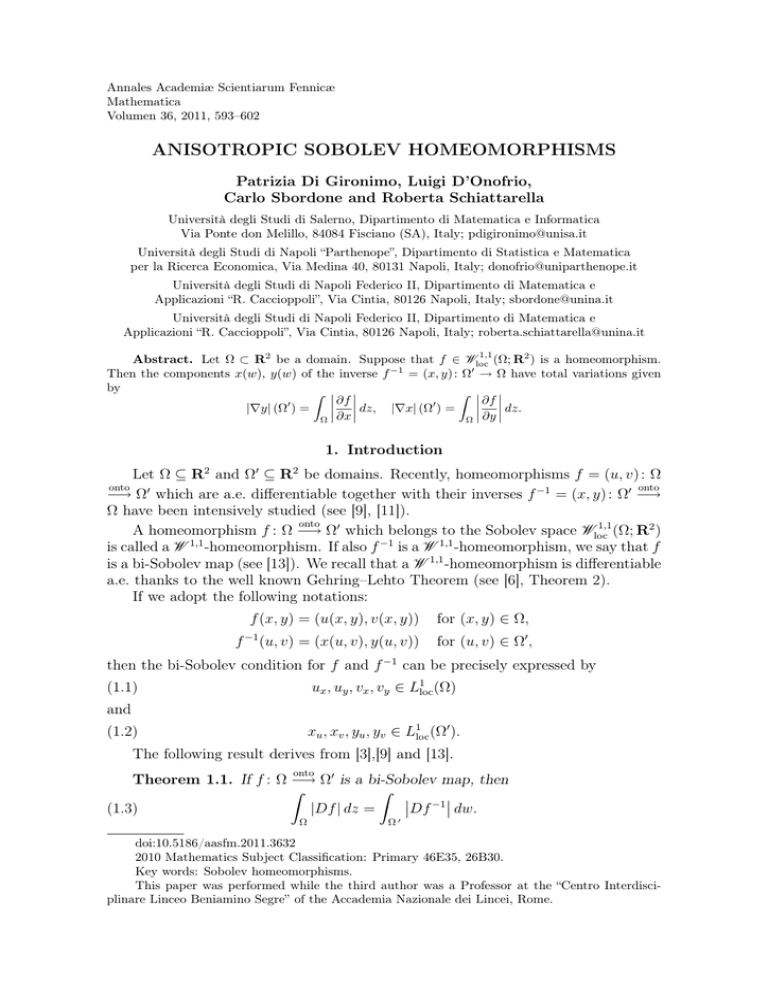
Annales Academiæ Scientiarum Fennicæ
Mathematica
Volumen 36, 2011, 593–602
ANISOTROPIC SOBOLEV HOMEOMORPHISMS
Patrizia Di Gironimo, Luigi D’Onofrio,
Carlo Sbordone and Roberta Schiattarella
Università degli Studi di Salerno, Dipartimento di Matematica e Informatica
Via Ponte don Melillo, 84084 Fisciano (SA), Italy; [email protected]
Università degli Studi di Napoli “Parthenope”, Dipartimento di Statistica e Matematica
per la Ricerca Economica, Via Medina 40, 80131 Napoli, Italy; [email protected]
Università degli Studi di Napoli Federico II, Dipartimento di Matematica e
Applicazioni “R. Caccioppoli”, Via Cintia, 80126 Napoli, Italy; [email protected]
Università degli Studi di Napoli Federico II, Dipartimento di Matematica e
Applicazioni “R. Caccioppoli”, Via Cintia, 80126 Napoli, Italy; [email protected]
1,1
Abstract. Let Ω ⊂ R2 be a domain. Suppose that f ∈ Wloc
(Ω; R2 ) is a homeomorphism.
Then the components x(w), y(w) of the inverse f −1 = (x, y) : Ω0 → Ω have total variations given
by
ˆ ¯ ¯
ˆ ¯ ¯
¯ ∂f ¯
¯ ∂f ¯
0
0
¯
¯
¯ ¯ dz.
|∇y| (Ω ) =
¯ ∂x ¯ dz, |∇x| (Ω ) =
¯ ∂y ¯
Ω
Ω
1. Introduction
Let Ω ⊆ R2 and Ω0 ⊆ R2 be domains. Recently, homeomorphisms f = (u, v) : Ω
onto
onto
−→ Ω0 which are a.e. differentiable together with their inverses f −1 = (x, y) : Ω0 −→
Ω have been intensively studied (see [9], [11]).
onto
1,1
A homeomorphism f : Ω −→ Ω0 which belongs to the Sobolev space Wloc
(Ω; R2 )
1,1
−1
1,1
is called a W -homeomorphism. If also f is a W -homeomorphism, we say that f
is a bi-Sobolev map (see [13]). We recall that a W 1,1 -homeomorphism is differentiable
a.e. thanks to the well known Gehring–Lehto Theorem (see [6], Theorem 2).
If we adopt the following notations:
f (x, y) = (u(x, y), v(x, y))
f
−1
(u, v) = (x(u, v), y(u, v))
for (x, y) ∈ Ω,
for (u, v) ∈ Ω0 ,
then the bi-Sobolev condition for f and f −1 can be precisely expressed by
ux , uy , vx , vy ∈ L1loc (Ω)
(1.1)
and
xu , xv , yu , yv ∈ L1loc (Ω0 ).
(1.2)
The following result derives from [3],[9] and [13].
onto
Theorem 1.1. If f : Ω −→ Ω0 is a bi-Sobolev map, then
ˆ
ˆ
¯ −1 ¯
¯Df ¯ dw.
(1.3)
|Df | dz =
Ω
Ω0
doi:10.5186/aasfm.2011.3632
2010 Mathematics Subject Classification: Primary 46E35, 26B30.
Key words: Sobolev homeomorphisms.
This paper was performed while the third author was a Professor at the “Centro Interdisciplinare Linceo Beniamino Segre” of the Accademia Nazionale dei Lincei, Rome.
594
Patrizia Di Gironimo, Luigi D’Onofrio, Carlo Sbordone and Roberta Schiattarella
If f is an a.e. differentiable homeomorphism, then the Jacobian determinant Jf
satisfies either the inequality Jf ≥ 0 or Jf ≤ 0 a.e. ([2], [12]). For simplicity let us
assume Jf (z) ≥ 0 for a.e. z ∈ Ω.
Let us point out that if the Jacobians Jf of f and Jf −1 of f −1 are strictly positive
a.e., it is possible to prove (1.3) by mean of the area formula (see Sections 2 and 3).
On the other hand, bi-Sobolev mappings do not enjoy such a property; it may happen
that their Jacobian vanishes on a set of positive measure ([19], [20], [14]).
The bi-Sobolev assumption rules out the Lipschitz homeomorphism
(1.4)
f0 : (0, 2) × (0, 1) → (0, 1) × (0, 1),
f0 (x, y) = (h(x), y) ,
where h−1 (t) = t + c(t) and c : (0, 1) → (0, 1) is the usual Cantor ternary function
1,1
because f0−1 does not belong to Wloc
. On the contrary, our first results deal with
1,1
W -homeomorphisms which include f0 as well (Theorem 1.3). Another interesting
property of a bi-Sobolev map f = (u, v) in the plane is that u and v have the same
critical points ([13], [17]).
onto
Theorem 1.2. Let f : Ω −→ Ω0 be a bi-Sobolev map f = (u, v) . Then u and v
have the same critical points:
(1.5)
{z ∈ Ω : |∇u(z)| = 0} = {z ∈ Ω : |∇v(z)| = 0}
a.e.
−1
The same result holds also for the inverse f . The analogue of this Theorem is
not valid in more than two dimensions (see [13]).
1,1
Let us point out that we only assume that f and f −1 are in Wloc
. In the cate1,p
gory of W 1,p -bi-Sobolev maps, that is, f belongs to Wloc
(Ω; R2 ) and f −1 belongs to
1,p
Wloc
(Ω0 ; R2 ), the case 1 ≤ p < 2 (see [20]) is critical with respect to the so-called
N property of Lusin, i.e., that a function maps every set of measure zero to a set of
measure zero. Let us mention that for W 1,2 -bi-Sobolev mappings the statement of
Theorem 1.2 is obviously satisfied. In fact (see [16], p. 150), for homeomorphisms in
1,2
Wloc
we have the N property. Clearly
{z ∈ Ω : |∇u(z)| = 0} ⊂ {z ∈ Ω : Jf (z) = 0}
a.e.
We can decompose the set {Jf = 0} into a null set Z and countably many sets on
which we can use the Sard’s Lemma (see [4], Theorem 3.1.8). It follows that
|f ({Jf = 0} \ Z)| = 0 and hence |f ({∇u = 0} \ Z)| = 0.
Since f −1 satisfies the N property, we obtain |{∇u = 0}| = 0 and analogously
|{∇v = 0}| = 0 as well.
We observe that the following identity
¯
¯
¯
¯
¾ ½
¾
½
¯ ∂f ¯
¯ ∂f ¯
a.e.
z ∈ Ω : ¯¯ (z)¯¯ = 0 = z ∈ Ω : ¯¯ (z)¯¯ = 0
∂x
∂y
¯
¯2
¯
¯2
¯ = u2x (z) + vx2 (z) and ¯¯ ∂f (z)¯¯ = u2y (z) + vy2 (z), is true for bi-Sobolev
where ¯ ∂f
(z)
∂x
∂y
maps and parallels (1.5). This is a consequence of the following characteristic property of a bi-Sobolev map which was proved in [3], [13], [9]:
(1.6)
Jf (z) = 0
=⇒
|Df (z)| = 0 a.e.
Our first result is the following, in which we give some identities for W 1,1 homeomorphism. Notice that the symbol |∇ϕ|(Ω0 ) denotes the total variation of
Anisotropic Sobolev homeomorphisms
595
the real function ϕ belonging to the space BV(Ω0 ) of functions of bounded variation
on Ω0 (see Section 2).
onto
Theorem 1.3. Let f = (u, v) : Ω ⊂ R2 −→ Ω0 ⊂ R2 be a homeomorphism
1,1
whose inverse is f −1 = (x, y). If we assume u, v ∈ Wloc
(Ω), then x, y ∈ BVloc (Ω0 )
and
¯
ˆ ¯
¯ ∂f ¯
0
¯
¯
(1.7)
|∇y| (Ω ) =
¯ ∂x (z)¯ dz,
Ω
¯
ˆ ¯
¯ ∂f ¯
0
¯ (z)¯ dz.
(1.8)
|∇x| (Ω ) =
¯
¯
Ω ∂y
onto
In [11] it was proved that if f : Ω ⊂ R2 −→ Ω0 ⊂ R2 has bounded variation,
f ∈ BVloc (Ω; R2 ), then f −1 ∈ BVloc (Ω0 ; R2 ) and both f and f −1 are differentiable
a.e. We notice that our identities (1.7) and (1.8) represent an improvement of such
a result when f is W 1,1 -homeomorphism; in particular the following estimate
ˆ
¯ −1 ¯ 0
¯Df ¯ (Ω ) ≤ 2 |Df | dz
Ω
1,p
Wloc -homeomorphism
holds (Corollary 3.4). A
in the plane, 1 ≤ p < 2 whose
Jacobian vanishes a.e., has been recently constructed by Hencl [8]; such a mapping
satisfies the assumptions of Theorem 1.3. If in Theorem 1.3 we add the hypothesis
Jf > 0 a.e., we obtain the identities (1.7) and (1.8) using the area formula (see
Sections 2 and 3).
Condition (1.6) makes it possible, for a given bi-Sobolev mapping f , to consider
the distortion quotient
(1.9)
|Df (z)|2
Jf (z)
for a.e. z ∈ Ω.
Hereafter the undetermined ratio 00 is understood to be equal to 1 for z in the zero
set of the Jacobian. The Borel function
2
|Df (z)|
if Jf (z) > 0,
(1.10)
Kf (z) :=
Jf (z)
1
otherwise,
is the distortion function of f and has relevant properties: it is the smallest function
K(z) greater or equal to 1 for which the distortion inequality:
(1.11)
|Df (z)|2 ≤ K(z)Jf (z) a.e. z ∈ Ω
holds true. Moreover, there are interesting interplay between the integrability of the
distortions Kf and Kf −1 and the regularity of f and f −1 (see [13], Theorem 5).
In our general context of W 1,1 -homeomorphisms there are different distortion
functions which play a significant role (see Section 4). We obtain conditions under
which one of these functions is finite a.e. or integrable.
2. Preliminaries
We denote by |A| the Lebesgue measure of a set A ⊂ R2 . We say that two sets
A, B ⊆ R2 satisfy A = B a.e. if their symmetrical difference has measure zero, i.e.,
|(A \ B) ∪ (B \ A)| = 0.
596
Patrizia Di Gironimo, Luigi D’Onofrio, Carlo Sbordone and Roberta Schiattarella
onto
A homeomorphic mapping f : Ω ⊂ R2 −→ Ω0 ⊂ R2 is said to satisfy the N property
of Lusin on the domain Ω if for every A ⊂ Ω such that |A| = 0 we have |f (A)| = 0.
A function u ∈ L 1 (Ω) is of bounded variation, u ∈ BV(Ω) if the distributional
partial derivatives of u are measures with finite total variation in Ω: there exist
Radon signed measures D1 u, D2 u in Ω such that for i = 1, 2, |Di u|(Ω) < ∞ and
ˆ
ˆ
uDi φ(z) dz = − φ(z) dDi u(z) ∀φ ∈ C01 (Ω).
Ω
Ω
The gradient of u is then a vector-valued measure with finite total variation
½ˆ
¾
1
2
|∇u| (Ω) = sup
u divϕ(z) dz : ϕ ∈ C0 (Ω, R ), kϕk∞ ≤ 1 < ∞.
Ω
By |∇u| we denote the total variation of the signed measure Du.
The Sobolev space W 1,1 (Ω) is´ contained in BV(Ω); indeed for any u ∈ W 1,1 (Ω)
the total variation is given by Ω |∇u| = |∇u| (Ω). We say that f = (u, v) ∈
L 1 (Ω; R2 ) belongs to BV(Ω; R2 ) if u, v ∈ BV(Ω). Finally we say that f ∈ BVloc (Ω; R2 )
if f ∈ BV(A; R2 ) for every open A ⊂⊂ Ω. In the following, for f ∈ BVloc (Ω; R2 ) we
will denote the total variation of f by:
¾
½ˆ
ˆ
1
2
u div ϕ1 (z) dz+ v div ϕ2 (z) dz : ϕi ∈ C0 (Ω; R ), kϕi k∞ ≤ 1, i = 1,2 .
|Df |(Ω) = sup
Ω
Ω
We will need the definition of sets of finite perimeter (see [1]).
Definition 2.1. Let E be a Lebesgue measurable subset of R2 . For any open
set Ω ⊂ R2 the perimeter of E in Ω, denoted by P (E, Ω), is the total variation of χE
in Ω, i.e.,
¾
½ˆ
1
2
div ϕ dz : ϕ ∈ C0 (Ω; R ), kϕk∞ ≤ 1 .
P (E, Ω) = sup
E
We say that E is a set of finite perimeter in Ω if P (E, Ω) < ∞.
1,p
We say that f = (u, v) ∈ Wloc
(Ω; R2 ), 1 ≤ p ≤ ∞, if for each open A ⊂⊂ Ω, f
belongs to the Sobolev space W 1,p (A; R2 ), i.e., if u ∈ L p (A) and v ∈ L p (A) have
distributional derivatives in L p (A).
1,1
We are interested in the area formula for a homeomorphism f ∈ Wloc
(Ω; R2 )
2
with Ω ⊂ R . In this case we have
ˆ
ˆ
(2.1)
η(f (z))Jf (z) dz ≤
η(w) dw
Ω
R2
for any non negative Borel function η on R2 . This follows from the area formula
for Lipschitz mappings (see [4], Theorem 3.2.3), and from a general property of a.e.
differentiable functions (see [4], Theorem 3.1.8), namely that Ω can be exhausted up
to a set of measure zero by sets the restriction to which of f is Lipschitz continuous.
Moreover, the area formula
ˆ
ˆ
(2.2)
η(f (z))Jf (z) dz =
η(w) dw
E
R2
holds on each set E ⊂ Ω on which the N property of Lusin is satisfied.
Anisotropic Sobolev homeomorphisms
597
3. The identities for W 1,1 -homeomorphisms
Before proving Theorem 1.3 in its full generality we give now a partial proof
under the following additional assumptions:
(3.1)
{w : Jf −1 (w) = 0} = {w :
½
{z : Jf (z) = 0} = z :
(3.2)
|∇y(w)| = 0} a.e.,
¯
¯
¾
¯ ∂f ¯
¯ (z)¯ = 0
a.e.,
¯ ∂x ¯
where Jf −1 denotes the determinant of the absolutely continuous part of Df −1 ; moreover, we suppose f −1 differentiable a.e. in the classical sense. Therefore, we have
ˆ
ˆ
|∇y(w)| dw,
|∇y(w)| dw =
A0
Ω0
where A0 is a Borel subset of the set E 0 where f −1 is differentiable with Jf −1 > 0
such that |A0 | = |E 0 |.
Applying (2.1), (3.1) and basic linear algebra, we arrive at:
ˆ
ˆ
ˆ
|∇y(w)|
|∇y(f (z))|
|∇y(w)| dw =
Jf −1 (w) dw ≤
dz
A0
A0 Jf −1 (w)
f −1 (A0 ) Jf −1 (f (z))
¯
¯
¯
ˆ
ˆ ¯
¯ ∂f ¯
¯ ∂f ¯
¯
¯
¯
¯
=
¯ ∂x (z)¯ dz ≤
¯ ∂x (z)¯ dz.
−1
0
f (A )
Ω
Here we are using the identity D adj D = I detD and the fact that Jf (z)Jf −1 (f (z)) =
1 at the points of differentiability with nonzero Jacobian. We have used
µ as well¶the
ux uy
expression of the inverse matrix to the differential 2 × 2 matrix Df =
in
vx vy
µ
¶
xu xv
terms of Df −1 =
, namely
yu yv
yu (f (z)) = −vx (z)Jf −1 (f (z)), yv (f (z)) = ux (z)Jf −1 (f (z)) ∀z ∈ f −1 (A0 ),
and the identity
£
¤
|∇y(f (z))|2 = vx (z)2 + ux (z)2 Jf −1 (f (z))2
∀z ∈ f −1 (A0 ).
The opposite inequality follows by a symmetric procedure which relies on (3.2).
Notice that (3.1) and (3.2) are certainly satisfied if Jf > 0 a.e. and Jf −1 > 0
a.e. We observe that Theorem 1.1 can be proved using the same technique under the
additional assumptions that Jf > 0 and Jf −1 > 0 a.e. In the general case the proof of
Theorem 1.3 is completely different; to prove the Theorem we need some preliminary
results. The next Lemma is known as Coarea Formula (see [1], Theorem 3.40):
1
Lemma 3.1. For any open set Ω0 ⊂ R2 and y ∈ Lloc
(Ω0 ) we have
ˆ +∞
0
(3.3)
|∇y| (Ω ) =
P ({w ∈ Ω0 : y(w) > t} , Ω0 ) dt.
−∞
We understand the left-hand side of (3.3) to be infinity if y ∈
/ BV.
The following Lemma is the main step towards the equality in the area formula
(see Theorem 1.3 of [3] and also [13], where the case f ACL, i.e., absolutely continuous
on lines, is treated).
598
Patrizia Di Gironimo, Luigi D’Onofrio, Carlo Sbordone and Roberta Schiattarella
1,1
Lemma 3.2. Let f ∈ Wloc
((−1, 1)2 ; R2 ) be a homeomorphism. Then for almost
every t ∈ (−1, 1) the mapping f|(−1,1)×{t} satisfies the N property of Lusin, i.e., for
every A ⊂ (−1, 1) × {t}, H 1 (A) = 0 implies H 1 (f (A)) = 0.
Proof of Theorem 1.3. Without loss of generality we take Ω = (−1, 1) × (−1, 1).
Let us apply Lemma 3.2 to the homeomorphism f . Then, the mapping
f (·, t) : x ∈ (−1, 1) 7→ (u(x, t), v(x, t)) ∈ Ω0
belongs to W 1,1 ((−1, 1), R2 ) for a.e. t and satisfies the N property. In particular, the
area formula holds for f (·, t) on (−1, 1):
¯
ˆ 1¯
¯ ∂f
¯
¡
¢
¯ (x, t)¯ dx = H 1 f ((−1, 1) × {t}) .
(3.4)
¯
¯
−1 ∂x
Integrating with respect to t we obtain:
¯
ˆ ¯
ˆ 1
¯ ∂f ¯
¡
¢
¯
¯
(3.5)
H 1 f ((−1, 1) × {t}) dt.
¯ ∂x (z)¯ dz =
Ω
−1
Since it is clear that
f ((−1, 1) × {t}) = {w ∈ Ω0 : y(w) = t} ,
then
¯
ˆ ¯
ˆ 1
¯ ∂f ¯
¯ (z)¯ dz =
H 1 ({w ∈ Ω0 : y(w) = t}) dt.
¯ ∂x ¯
Ω
−1
As y is continuous, then the set {w ∈ Ω0 : y(w) = t} is the boundary of the level set
{w ∈ Ω0 : y(w) > t}. By assumptions we know that for a.e. t, H 1 ({w ∈ Ω0 : y(w) =
t}) < ∞ and from [1] (p. 209) we have
H 1 ({w ∈ Ω0 : y(w) = t}) = P ({w ∈ Ω0 : y(w) > t} , Ω0 )
a.e. t ∈ (−1, 1).
Using Coarea Formula from Lemma 3.1, we obtain
¯
ˆ ¯
¯ ∂f ¯
0
¯
¯
|∇y|(Ω ) =
¯ ∂x (z)¯ dz
Ω
and we deduce that y ∈ BVloc (Ω0 ).
The equality (1.8) is proved using the same technique.
¤
Remark 3.3. From the above proof it is clear that if f is a homeomorphism in
∂f
∈ L 1 (Ω; R2 ), then (1.7) holds true.
BVloc (Ω; R2 ) such that
∂x
Since the total variation of a map is less or equal than the sum of total variation
of the components, by Theorem 1.3 we immediately get
onto
Corollary 3.4. Let f = (u, v) : Ω ⊂ R2 −→ Ω0 ⊂ R2 be a homeomorphism
1,1
whose inverse is f −1 = (x, y). If we assume u, v ∈ Wloc
(Ω), then
ˆ
¯ −1 ¯ 0
¯
¯
(Ω ) ≤ 2 |Df | .
(3.6)
Df
Ω
Anisotropic Sobolev homeomorphisms
599
4. The distortions of anisotropic Sobolev maps
onto
In Section 1 we have already mentioned the known fact that, if f : Ω ⊂ R2 −→
0
Ω ⊂ R2 is bi-Sobolev , then we have
{z : Jf (z) = 0} = {z : |Df (z)| = 0}
a.e.
and this makes it possible to consider the distortion function
2
|Df (z)|
if Jf (z) > 0,
(4.1)
Kf (z) :=
Jf (z)
1
otherwise.
Moreover, the distortion inequality
|Df (z)|2 ≤ Kf (z)Jf (z)
holds for a.e. z ∈ Ω. According to a well established terminology, we say that f has
finite distortion Kf .
For a Sobolev homeomorphism, under suitable assumptions, it is possible to introduce different distortion functions (see [21]). Namely, if f = (u, v) satisfies the
condition
{z : Jf (z) = 0} = {z : |∇u(z)| = 0} a.e.,
then we are allowed to define the Borel function
2
|∇u(z)|
if Jf (z) > 0,
(1)
(4.2)
Kf (z) :=
Jf (z)
1
otherwise.
Similarly, if f = (u, v) satisfies the condition
{z : Jf (z) = 0} = {z : |∇v(z)| = 0}
then the Borel function
(4.3)
2
|∇v(z)|
(2)
Kf (z) :=
J (z)
f
1
a.e.,
if Jf (z) > 0,
otherwise,
is well defined. On the other hand, if f = (u, v) satisfies the condition
¯
¾
½ ¯
¯ ∂f ¯
a.e.,
{z : Jf (z) = 0} = z : ¯¯ (z)¯¯ = 0
∂x
then we can define the Borel function
¯
¯2
∂f
¯ ∂x (z)¯
(1)
(4.4)
Hf (z) :=
Jf (z)
1
Finally, for f satisfying
{z : Jf (z) = 0} =
½
if Jf (z) > 0,
otherwise.
¯
¯
¾
¯ ∂f ¯
z : ¯¯ (z)¯¯ = 0
∂y
a.e.
600
Patrizia Di Gironimo, Luigi D’Onofrio, Carlo Sbordone and Roberta Schiattarella
we define
(2)
(4.5)
Hf (z) :=
¯
¯
¯ ∂f ¯2
¯ ∂y (z)¯
if Jf (z) > 0,
Jf (z)
1
otherwise.
In the following, given a W 1,1 -homeomorphism f , we establish conditions which guarantee that one of its distortions is finite a.e. or L 1 . Let us begin with the following
onto
Theorem 4.1. Let f = (u, v) : Ω ⊂ R2 −→ Ω0 ⊂ R2 be a W 1,1 - homeomorphism
1,1
whose inverse is f −1 = (x, y). If x ∈ Wloc
(Ω0 ) and vy 6= 0 on a positive measure set
P ⊂ Ω, then
¯
¯
½
¾
¯ ∂f ¯
¯
¯
a.e.
(4.6)
{z ∈ P : Jf (z) = 0} = z ∈ P : ¯ (z)¯ = 0
∂y
(2)
and the distortion Hf (z) is finite a.e. Moreover, we have the following identities
¯
ˆ
ˆ ¯
¯ ∂f ¯
¯
¯
(4.7)
|∇x(w)| dw =
¯ ∂y (z)¯ dz
0
Ω
Ω
¯
ˆ ¯
¯ ∂f ¯
0
¯
¯
|∇y(w)| (Ω ) =
(4.8)
¯ ∂x (z)¯ dz.
Ω
Proof. By contradiction we suppose that there exists a set A ⊂ P with positive
Lebesgue measure such that f is differentiable in A and
¯
¯
¯ ∂f ¯
Jf (z) = 0 and ¯¯ (z)¯¯ > 0 ∀z ∈ A.
∂y
We can assume that f is Lipschitz on A and use the area formula (2.2) to get
ˆ
|f (A)| = 0 since
Jf (z) dz = 0.
A
We denote by
©
ª
p2 : (x1 , x2 ) ∈ R2 → H2 = x ∈ R2 : x2 = 0
the orthogonal projection and by
p(2) : (x1 , x2 ) ∈ R2 → x2 ∈ R
the second coordinate function.
We observe that
¡
¢−1
{ω ∈ Ω0 : x(ω) = t} = p2 ◦ f −1
{(t, 0)} ∀t ∈ R.
By assumptions we know that
H 1 ({w ∈ f (A) : x(w) = t}) < ∞
and from [1] (p. 209)
H 1 ({w ∈ f (A) : x(ω) = t}) = P ({w ∈ f (A) : x(w) > t} , Ω0 ) .
1,1
By Lemma 3.1 and the assumption that x belongs to Wloc
(Ω0 ), we have
ˆ
ˆ
H 1 ({w ∈ f (A) : x(w) = t}) =
|∇x(ω)| dw = 0.
R
f (A)
Anisotropic Sobolev homeomorphisms
601
Thus the curve {w ∈ f (A) : x(w) = t} has zero one dimensional measure for a.e.
t ∈ R and in particular its second projection to the axis have zero one-dimensional
measure as well:
¢
¡
(4.9)
H 1 p(2) ({w ∈ f (A) : x(ω) = t}) = 0 a.e. t ∈ R.
On the other hand, using Fubini Theorem, we have
ˆ
¯
¯
¯A ∩ p−1
¯
|A| =
2 {(t, 0)} dt > 0.
R
Hence, there exists t0 ∈ R such that
¡
¢
H 1 A ∩ p−1
2 {(t0 , 0)} > 0.
Applying the area formula to the differentiable function v(t0 , ·) : τ ∈ p(2) (A) →
v(t0 , τ ), we have
ˆ
ˆ
1
0<
|vy (t0 , τ )| dH (τ ) ≤
N (v, A ∩ p−1
2 (t0 ), σ) dσ
−1
A∩p2 (t0 )
R
ˆ
(4.10)
=
N (v, A ∩ p−1
2 (t0 ), σ) dσ,
p(2) (f (A)∩(p2 ◦f −1 )−1 (t0 ))
−1
where N (v, A ∩ p−1
2 (t0 ), σ) is the number of preimages of σ under v in A ∩ p2 (t0 ).
The last integral is zero by (4.9) and this is a contradiction.
¤
(2)
The following result shows that if the distortion Kf is L 1 , then f −1 has better
Sobolev regularity.
onto
Theorem 4.2. Let f = (u, v) : Ω ⊂ R2 −→ Ω0 ⊂ R2 be a W 1,1 -homeomorphism
and denote by f −1 = (x, y) its inverse. If we assume
¯ −1
¯
½
¾
¯
¯
0
0 ¯ ∂f
(4.11)
{w ∈ Ω : Jf −1 (w) = 0} = w ∈ Ω : ¯
(w)¯¯ = 0 ,
∂u
(4.12)
{z ∈ Ω : Jf (z) = 0} = {z ∈ Ω : |∇v(z)| = 0}
(2)
and Kf ∈ L 1 , then
(4.13)
and
(4.14)
¯ −1 ¯
¯ ∂f ¯
2
¯
¯
¯ ∂u ¯ ∈ L (Ω)
¯2
ˆ
ˆ ¯ −1
¯
¯ ∂f
(2)
¯
¯
Kf (z) dz.
¯ ∂u (w)¯ dw ≤
0
Ω
Ω
Proof. Let A0 be the Borel subset of the set E 0 where f −1 is differentiable with
Jf −1 > 0, such that |A0 | = |E 0 |. Applying the area formula, we obtain
¯
¯2
¯2
¯2
ˆ ¯ −1
ˆ ¯ −1
ˆ ¯¯ ∂f −1 (w)¯¯
¯ ∂f
¯ ∂f
¯
¯
∂u
¯
¯
(w)¯¯ dw =
(w)¯¯ dw =
Jf −1 (w) dw
¯
¯
∂u
∂u
Ω0
A0
A0 Jf −1 (w)
¯ −1
¯2
¯ ∂f
¯
ˆ
ˆ
1
¯ ∂u (f (z))¯
|∇v(z)|2
Jf (z)2
dz =
dz
≤
Jf −1 (f (z))
f −1 (A0 )
f −1 (A0 ) Jf −1 (f (z))
602
Patrizia Di Gironimo, Luigi D’Onofrio, Carlo Sbordone and Roberta Schiattarella
ˆ
=
f −1 (A0 )
|∇v(z)|2
dz ≤
Jf (z)
ˆ
(2)
Ω0
Kf (z) dz.
¤
References
[1] Ambrosio, L., N. Fusco, and D. Pallara: Functions of bounded variation and free discontinuity problems. - Oxford Math. Monogr., Oxford Univ. Press, New York, 2000.
[2] Astala, K., T. Iwaniec, and G. Martin: Elliptic partial differential equations and quasiconformal mappings in the plane. - Princeton Math. Ser. 48, Princeton Univ. Press, Princeton,
NJ, 2009.
[3] Csörnyei, M., S. Hencl, and J. Malý: Homeomorphisms in the Sobolev space W 1,n−1 . J. Reine Angew. Math. 644, 2010, 221–235.
[4] Federer, H.: Geometric measure theory. - Grundlehren Math. Wiss. 153, Springer-Verlag,
New York, 1969 (second edition 1996).
[5] Fusco, N., G. Moscariello, and C. Sbordone: The limit of W 1,1 homeomorphisms with
finite distortion. - Calc. Var. Partial Differential Equations 33:3, 2008, 377–390.
[6] Gehring, F. W., and O. Lehto: On the total differentiability of functions of a complex
variable. - Ann. Acad. Sci. Fenn. Ser. A I Math. 272, 1959, 1–9.
[7] Greco, L., C. Sbordone, and R. Schiattarella: Composition of bi-Sobolev homeomorphisms. - Proc. Roy. Soc. Edinburgh Sect. A (to appear).
[8] Hencl, S.: Sobolev homeomorphism with zero jacobian almost everywhere. - J. Math. Pures
Appl. (to appear).
[9] Hencl, S., and P. Koskela: Regularity of the inverse of a planar Sobolev homeomorphism.
- Arch. Ration. Mech. Anal. 180, 2006, 75–95.
[10] Hencl, S., P. Koskela, and J. Malý: Regularity of the inverse of a Sobolev homeomorphism
in space. - Proc. Roy. Soc. Edinburgh Sect. A 136:6, 2006, 1267–1285.
[11] Hencl, S., P. Koskela, and J. Onninen: Homeomorphisms of bounded variation. - Arch.
Ration. Mech. Anal. 186, 2007, 351–360.
[12] Hencl, S., and J. Malý: Jacobians of Sobolev homeomorphisms. - Calc. Var. Partial Differential Equations 38: 1-2, 2010, 233–242.
[13] Hencl, S., G. Moscariello, A. Passarelli di Napoli, and C. Sbordone: Bi-Sobolev
mappings and elliptic equations in the plane. - J. Math. Anal. Appl. 355, 2009, 22–32.
[14] Iwaniec, T., and G. Martin: Geometric function theory and non-linear analysis. - Oxford
Math. Monogr., The Clarendon Press, Oxford Univ. Press, New York, 2001.
[15] Koskela, P.: Regularity of the inverse of a Sobolev homeomorphism. - In: Proc. Internat.
Congress of Mathematicians, Hyderabad, India, 2010.
[16] Lehto, O., and K. Virtanen: Quasiconformal mappings in the plane. - Springer-Verlag,
Berlin, 1971.
[17] Moscariello, G., A. Passarelli di Napoli, and C. Sbordone: ACL-homeomorphisms
in the plane. - Oper. Theory Adv. Appl. 193, 2009, 215–225.
[18] Moscariello, G., A. Passarelli di Napoli, and C. Sbordone: Planar ACL-homeomorphisms: critical points of their components. - Commun. Pure Appl. Anal. 9:5, 2010, 1391–1397.
[19] Ponomarev, S.: An example of an ACT Lp homeomorphisms that is not absolutely continuous
in the sense of Banach. - Dokl. Akad. Nauk SSSR 201, 1971, 1053–1054.
[20] Ponomarev, S.: On the N-property of homeomorphisms of the class Wp1 . - Sibirsk. Mat. Zh.
28, 1987, 140–148.
[21] Sbordone, C., and R. Schiattarella: Critical points for Sobolev homeomorphisms. - Rend.
Mat. Accad. Lincei, 2011 (to appear).
Received 17 December 2010

